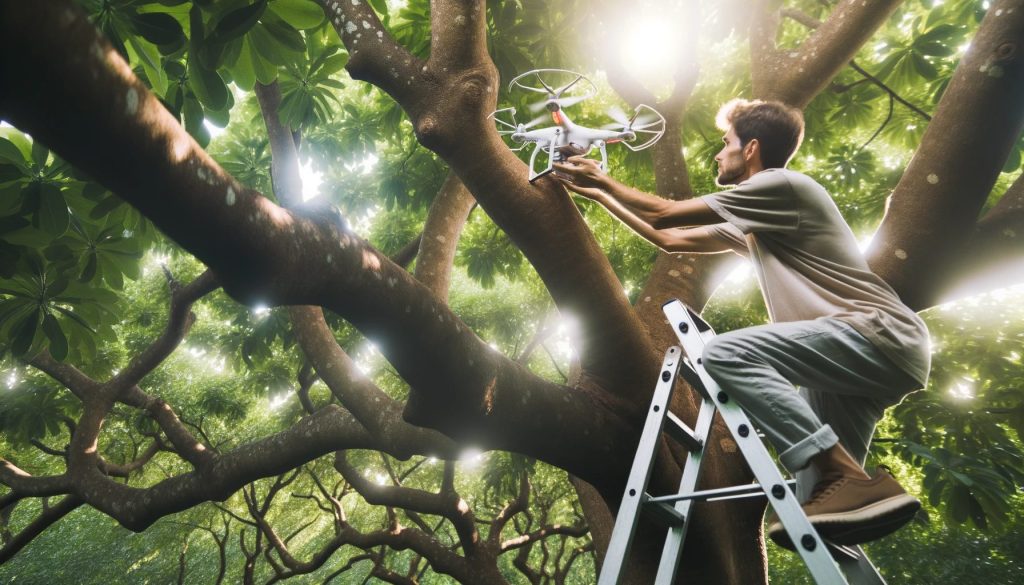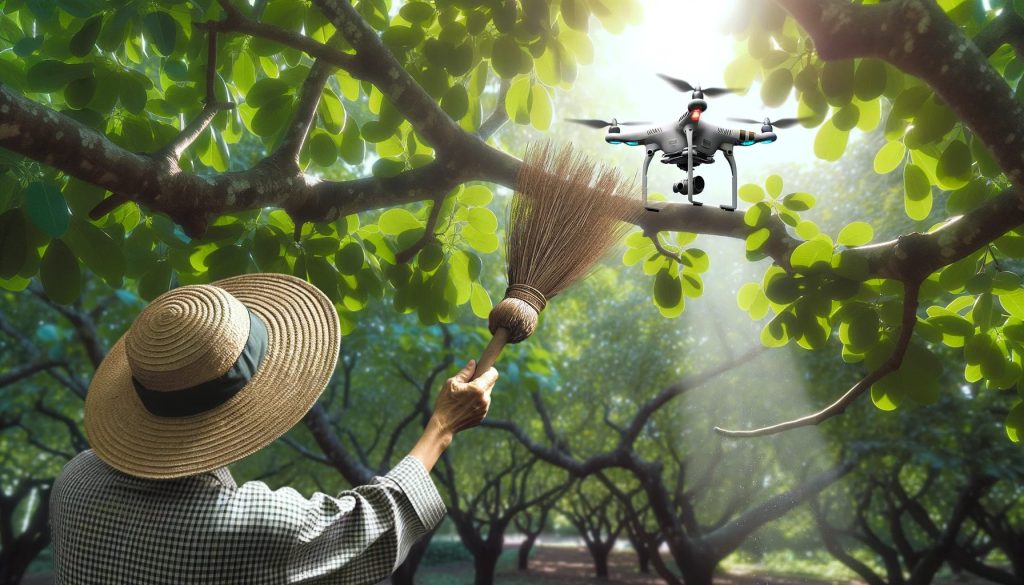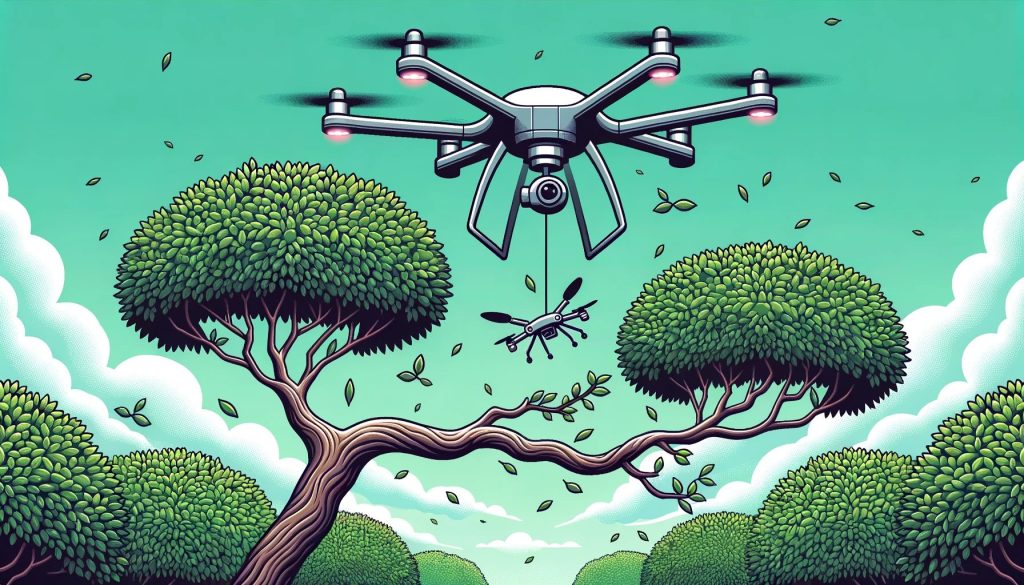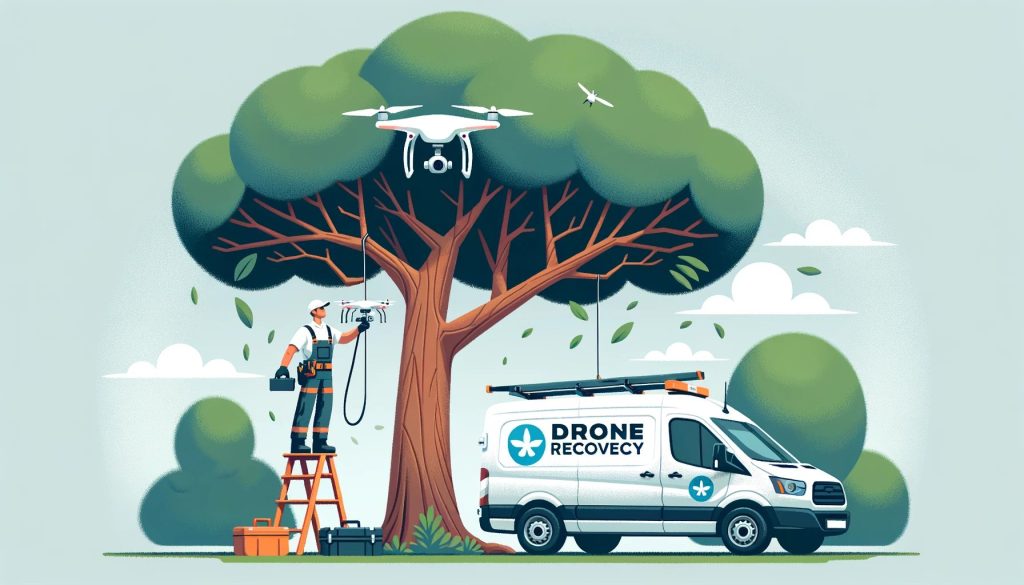Drones have revolutionized the way we capture breathtaking aerial views, monitor landscapes, and even deliver packages. But as any drone enthusiast knows, these flying marvels aren’t immune to mishaps. One of the most common and frustrating challenges faced by drone pilots is the dreaded tree entanglement.
Whether it’s a gust of wind, a momentary lapse in control, or an unexpected obstacle, drones can easily find themselves lodged high up in the branches, leaving their operators on the ground, looking up in dismay. If you’ve ever found yourself in this predicament or want to be prepared for when it happens, you’re in the right place.
There are a couple of things you can do to get your drone out of the tree, including climbing up the tree, climbing using a Ladder, Using a Long Pole or Broomstick, Controlling the Drone when it still has power, Using another Drone and the list goes on.
In this guide, we’ll explore those tried-and-tested methods from various drone pilots to safely retrieve drones from those lofty heights. Let’s start:
Avoid Getting Your Drone Stuck in the First Place
The best solution to any problem is often prevention. When it comes to drones, avoiding tree entanglements should be a top priority for every drone pilot.
Here’s how you can ensure safer flights:
- Pre-Flight Checks: Before taking off, always ensure your drone’s sensors, cameras, and propellers are in optimal condition. A malfunctioning sensor or a slightly damaged propeller can affect the drone’s stability and control.
- Know Your Environment: Familiarize yourself with the flying area. Look out for tall trees, power lines, and other potential obstacles. Using mapping apps or doing a quick ground reconnaissance can give you a clear picture of potential hazards.
- Stay Updated: Ensure your drone’s firmware is up-to-date. Manufacturers often release updates that improve flight stability, obstacle detection, and overall performance.
- Practice Makes Perfect: If you’re a beginner, practice flying drones in open spaces without any obstructions. As you gain confidence and improve your piloting skills, you can venture into areas with more obstacles.
- Use Assisted Flying Modes: Modern drones come with features like obstacle avoidance. Engage these modes, especially when flying in areas with dense vegetation.
- Stay Alert: Always keep an eye on the drone and its surroundings. Avoid getting too engrossed in the camera feed, as this can distract you from potential hazards.
Immediate Actions After Drone getting stuck in the tree
Climb up the tree

When your drone is stuck in the tree, sometimes the old-school method of climbing the tree is the way to go. But before you channel your inner Tarzan, here’s what I’ve learned from my own tree-climbing escapades:
- Assess the Situation: Not all trees are climb-friendly. Take a moment to size up the tree. Does it have sturdy branches? Is it a tall tree or risky?
- Gear Up: Wear gloves to protect your hands and shoes with a good grip. Trust me, slipping isn’t fun.
- Safety First: If you’re not confident in your climbing skills or if the tree looks challenging, it might be best to call in a favor from a friend who’s more adept at climbing.
- Gentle Approach: Once you’re up there, approach your drone gently. The last thing you want is to accidentally knock it further out of reach.
- Plan Your Descent: Getting up is only half the battle. Ensure you have a safe way down, especially if you’re holding onto your drone.
Climb using a Ladder

One of the most straightforward and safest methods to consider is using a ladder. First and foremost, it’s essential to choose a ladder that’s both sturdy and tall enough to reach the drone without requiring you to overstretch.
The foundation upon which the ladder rests is equally crucial. Always ensure the ladder is positioned on a flat, firm surface to avoid any wobbling or potential mishaps. Before making your ascent, it’s a good practice to give the ladder a once-over, checking for any signs of damage or instability.
As you climb, remember the golden rule of maintaining three points of contact. This could be two hands and one foot or vice versa. This technique ensures stability and significantly reduces the risk of any missteps. Once you’re within arm’s reach of your drone, approach the task of retrieval with care and gentleness. A hasty move might dislodge the drone or, worse, send it crashing to the ground.
With patience, caution, and the right ladder, your drone will be back in your hands in no time.
Using a Long Pole or Broomstick

You see, sometimes, the simplest tools, the ones we pass by in our garage or storage room every day, can be the most effective. A long pole or that broomstick you use to chase away cobwebs can be your trusty sidekick in this drone retrieval saga. Extend it skyward, reaching out to your drone like a friend offering a hand. With gentle nudges and a bit of maneuvering, you can coax your drone from its leafy perch and back into your arms.
It’s a dance of patience and precision, but with each gentle prod, you’re not just retrieving a piece of tech; you’re reclaiming a piece of your passion. So, the next time your drone decides to mingle with the birds, remember that sometimes, all you need is a bit of an extended touch.
Try Controlling the Drone(if it still has power)
Before you consider more drastic retrieval methods, there’s one avenue you might not have explored fully: controlling the drone, provided it still has some juice left.
Try controlling the drone if possible. Sometimes, drones get themselves out of the tree when operated properly. So, you might want to try this. But yes, precision and control are paramount, as any misstep could destroy the drone.
In all cases, safety should be the top priority. Always put safety first before doing any attempt.
Use another Drone

Always ensure that the rescue drone has sufficient battery life and is capable of carrying the weight of the stuck drone, especially if it needs to be lifted slightly to disentangle it.
Choose the Right Drone: Ensure the second drone is equipped with the necessary features, like a camera for precision and a hook or claw attachment for retrieval.
Scout the Area: Before diving into the drone rescue, use the second drone’s camera to get a bird’s-eye view of the situation. This will help you strategize the best approach.
Steady Hands, Steady Flight: Precision is key. Approach the stranded drone slowly and steadily, avoiding any sudden movements.
Here are 2 techniques on how to use another drone to get the drone out of a tree:
- Tangle-Free Tactics: If the trapped drone is ensnared in branches, consider using the second drone to gently shake the tree branch or nudge the trapped drone free.
- Using ropes and strings: Some enthusiasts have even attached lightweight ropes or strings to their rescue drones, allowing them to either pull the trapped drone free or create a line that can be used for further retrieval methods. However, this technique requires a certain level of expertise in drone piloting to ensure success. It’s essential to assess the situation carefully; if the trapped drone is too entangled, using another drone might not be the best solution.
Always be cautious of the surroundings. Ensure there are no power lines, birds, or other obstacles that could interfere with the drone rescue mission.
Lastly, If the rescue seems too risky or if there’s potential for further entanglement, it might be best to reconsider and opt for a different retrieval method.
Another Great Way to Get the Drone Out of the Tree
Here is just another method of getting your drone out of the tree. For this, you need a couple of tools.
The materials you need:
- Latex surgical tubing
- Electrical tape
- Fishing reel
- String or thin rope
- Wooden dowels
- PVC pipe
Constructing the Recovery System:
- Attach the fishing reel to one end of the PVC pipe, ensuring it’s securely fastened.
- Secure the latex surgical tubing to the other end of the pipe using electrical tape. This will act as a slingshot mechanism.
- Create small projectiles using wooden dowels, which can be launched using the surgical tubing.
- Attach the string or thin rope to these projectiles.
Using the Recovery System:
- Aim the PVC pipe upwards, targeting the area near the stuck drone.
- Use the surgical tubing to launch the projectile, ensuring the string follows its trajectory.
- Once the projectile goes over the branch or area where the drone is stuck, you can use the attached string or rope to shake the tree branch or pull the drone free.
Always ensure you’re using the recovery system in a safe environment. Avoid areas with power lines or places where the system could cause harm or damage.
Below is the video version of the exact recovery method that was just discussed above. Watch the video for convenience:
Seeking Professional Help

Certain situations demand a level of expertise that only professionals can provide. Whether your drone is lodged high up in a towering tree or entangled in hard-to-reach places, professionals come equipped with the right tools and knowledge to handle the situation.
- They often have specialized equipment, from extended poles to safety harnesses, ensuring the retrieval process is both safe and efficient.
- Their experience means they can assess the situation quickly, determining the best course of action to minimize potential damage to your drone.
- Beyond just retrieval, professionals can also offer insights into any repairs or maintenance your drone might need post-rescue.
- Opting for professional help can also save you time, especially if the drone is trapped in a particularly challenging spot.
In essence, sometimes, the wisest decision is to trust the experts. After all, ensuring the safety and longevity of your drone is paramount.
Conclusion
Throughout this guide, we’ve journeyed through various methods of retrieval, from the hands-on approach of climbing to the wisdom of seeking professional help. Each situation is unique, and while there’s no one-size-fits-all solution, there’s a wealth of options to consider.
But beyond the practical tips and techniques, there’s a deeper lesson to be gleaned. It’s about resilience, adaptability, and the understanding that not every flight will be smooth. There will be detours and unexpected pit stops. Yet, with each challenge comes growth and knowledge.
So, the next time your drone decides to mingle with the treetops, don’t forget to try the methods discussed the methods.

